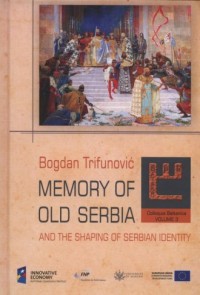Memory of Old Serbia and the Shaping of Serbian Identity. Seria: Colloquia Balkanica vol. 3
Bogdan Trifunović

| Dane szczegółowe: | |
| Wydawca: | DiG |
| Rok wyd.: | 2015 |
| Oprawa: | twarda |
| Ilość stron: | 196 s. |
| Wymiar: | 170x245 mm |
| EAN: | 9788371819292 |
| ISBN: | 978-83-7181-929-2 |
| Data: | 2016-02-08 |
Opis książki:
This book investigates the development of Serbian national identity in the context of the culture of memory that developed out of the discourse on Old Serbia, in the 19th and early 20th century. The term Old Serbia in the Serbian national discourse describes the lands once part of the medieval Serbian state, including the south of the Principality of Serbia and the adjacent lands under Ottoman rule from the 15th until the 20th century: the vilayets of Kosovo, Monastir and Salonica. Our hypothesis is that the discourse on Old Serbia became an element of collective remembrance only through the ideological deconstruction of the folk traditions, legends, and myths that formed the image of medieval Serbian history, in the second half of the 19th century. The political context of this process was Serbia’s strategic decision to expand towards the south, which emerged after the Congress of Berlin. The ideological concept of Old Serbia was created, and molded in order to correspond with the Serbia s new geo-strategic aims. This ideology of an ‘Old Serbia’ was the counterpart of the two other great ideas of the 19th century Balkan nationalisms: the Megali Idea and San Stefano Bulgaria. Our analysis of the mythical and ideological roots of Old Serbia (Chapter I), the production of memory of Old Serbia in textual, graphical and visual sources (Chapter II), and the reception of Old Serbia in visual arts and poetry (Chapter III) shows that discourse on Old Serbia was an important element of the national identity among the Serbs in the late 19th and early 20th century. The principal influence of the discourse on Old Serbia on the formation of Serbian national identity was its ability to connect as an unbroken bond, the Serbian Medieval Ages and modern state created after the uprisings against the Ottoman rule (1804-1815). The main source of this development was the contemporary Serbian intellectual, cultural and political elite and its construction of this continuity and permanent identity between the modern and medieval Serbian states, particularly with the 14th century empire of the Emperor Stefan Dušan. The bond between these two traditions was embodied in the tradition of Old Serbia.
Koedytent: Wydział „Artes Liberales” Uniwersytet Warszawski
Książka "Memory of Old Serbia and the Shaping of Serbian Identity. Seria: Colloquia Balkanica vol. 3" - Bogdan Trifunović - oprawa twarda - Wydawnictwo DiG. Książka posiada 196 stron i została wydana w 2015 r.
Spis treści:
ACKNOWLEDGMENTS 7
INTRODUCTION .. 9
Historical Context ... 11
Theoretical Concept 14
Methodology . 15
Overview of Sources and Literature 17
Structure of the Book ... 20
Chapter I . 23
Old Serbia — Genesis of an Idea 23
Introduction ... 23
Historical Narrative and Mythical Legacy 26
Vidovdan ... 33
The Influence of Jovan Rajić . 36
Old Serbia in the Debate on Maps ... 47
Literary Sources . 58
Načertanije: the National Program as an Influence .. 67
Conclusions ... 72
Chapter II 74
Forging the Memory of Old Serbia ... 74
Introduction ... 74
The Context of Education . 77
The Context of 1878 85
The Execution of an Ideology 87
The Society of Saint Sava . 89
Old Serbians on Old Serbia 91
Mapping Old Serbia 92
Seeking Old Serbia .. 98
A Forged Memory of Old Serbia: Old Serbia vs. Macedonia . 103
The Fifth Centenary of the Battle of Kosovo . 107
Phases in Forging Memory of Old Serbia . 109
Conclusions ... 110
Chapter III ... 112
The Reception of Old Serbia .. 112
Introduction ... 113
Old Serbia as an Artistic Destination and Inspiration ... 114
Visualization of Sites of Memory 117
An Emperor between History and Memory 118
The Tale of the Painting 121
Outlining a Mental Map 123
Stefan Dušan and the Empire .. 126
Poetics of Old Serbia 131
Poetic Reception of the Sites of Memory ... 137
The Cultural Range of Old Serbia 140
Notion of Space and Time .. 146
Confronting Perspectives on Shared Sites of Memory .. 149
Conclusions ... 153
CONCLUSIONS 154
REFERENCES . 161
IMAGES, MAPS AND ILLUSTRATIONS . 180
INDEX OF NAMES, AUTHORS, GEOGRAPHICAL NAMES
AND EVENTS .. 183

